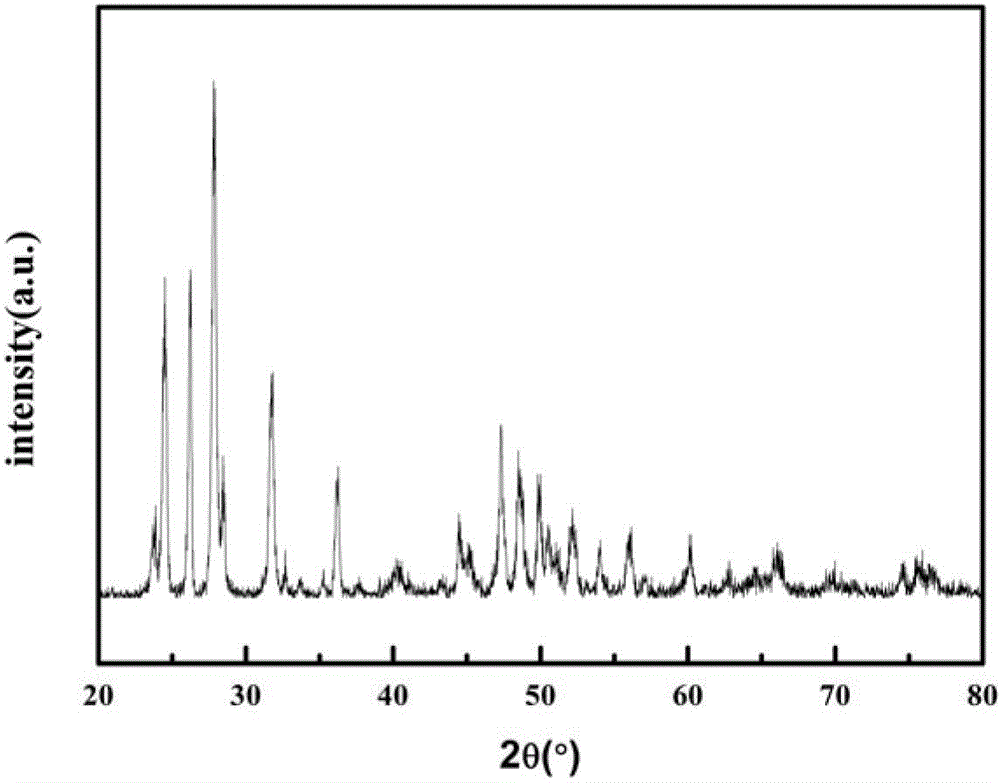Up-and-down-conversion luminescent high-transmittance amorphous fluoride film and preparation method thereof
A fluoride and thin film technology, applied in the field of high-transparency amorphous fluoride thin film and its preparation, can solve problems such as low transmittance, achieve the effects of high transmittance, improve photoelectric conversion efficiency, and reduce light reflection
- Summary
- Abstract
- Description
- Claims
- Application Information
AI Technical Summary
Problems solved by technology
Method used
Image
Examples
Embodiment 1
[0032] (1) In YbF 3 Add ErF to the powder 3 Powder, where ErF 3 The mole fraction of the powder is 5%, then ball milled and mixed, dried and pressed into tablets, and calcined at 600°C for 8 hours by carbon coating to make a ceramic target. The XRD pattern of its ceramic target material (see figure 1 ) basically conforms to YbF 3 PDF 34-0102 Diffraction Standard Spectrum.
[0033] (2) YbF prepared by the above method 3 : Er ceramic target material, using electron beam deposition method: using silicon wafer as the substrate, under vacuum conditions, the substrate temperature is 500°C, the target distance is 32cm, the deposition beam current is 4, and the deposition time is 15min to obtain YbF 3 film.
Embodiment 2
[0035] (1) In YbF 3 Add ErF to the powder 3 Powder, where ErF 3 The mole fraction of the powder is 5%, and then ball milled and mixed, dried and pressed into tablets, and calcined at 650°C for 8 hours by carbon coating, and fired into a ceramic target.
[0036] (2) YbF prepared by the above method 3 : Er ceramic target material, using electron beam deposition method: using silicon wafer as the substrate, under vacuum conditions, the substrate temperature is 500 ℃, the target distance is 32cm, the deposition beam current is 3, and the deposition time is 60min to obtain YbF 3 film, its XRD pattern is shown in figure 2 .
Embodiment 3
[0038] (1) In YbF 3 Add ErF to the powder 3 Powder, where ErF 3 The mole fraction of the powder is 10%, then ball milled and mixed, dried and pressed into tablets, and calcined at 750°C for 8 hours by carbon coating to make a ceramic target. Its XRD pattern is shown in image 3 .
[0039] (2) YbF prepared by the above method 3 : Er ceramic target material, using the electron beam deposition method: using a silicon wafer as the substrate, under vacuum conditions, the substrate temperature is 500°C, the target distance is 32cm, the deposition beam current is 5, and the deposition time is 60min to obtain YbF 3 film, its XRD pattern is shown in Figure 4 . Use the FLS920 fluorescence spectrometer to measure the emission spectrum at room temperature under the excitation condition of 378nm. For the emission spectrum, see Figure 5 ; For the luminescence spectrum excited at 980nm see Figure 6 .
PUM
 Login to View More
Login to View More Abstract
Description
Claims
Application Information
 Login to View More
Login to View More - R&D
- Intellectual Property
- Life Sciences
- Materials
- Tech Scout
- Unparalleled Data Quality
- Higher Quality Content
- 60% Fewer Hallucinations
Browse by: Latest US Patents, China's latest patents, Technical Efficacy Thesaurus, Application Domain, Technology Topic, Popular Technical Reports.
© 2025 PatSnap. All rights reserved.Legal|Privacy policy|Modern Slavery Act Transparency Statement|Sitemap|About US| Contact US: help@patsnap.com



